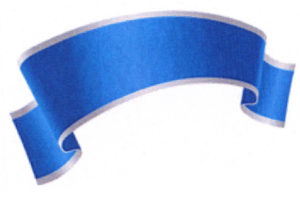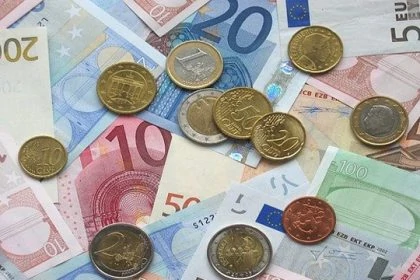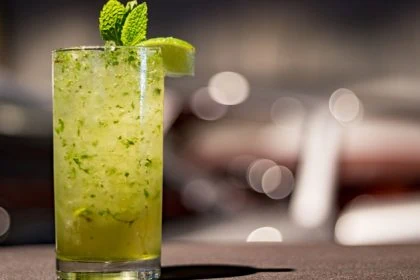In today’s preliminary ruling by the Advocate General of the ECJ, important questions relating to graphic marks will be clarified. A figurative mark cannot be applied for as a colour mark and there are clear differences in the distinctiveness of figurative and colour marks.
Today it is the next definitive judgment in the border area between the colour mark and the figurative mark after the sensational years of trademark dispute over the red sole of the famous Louboutin shoes ( Louboutin victorious in the battle over the famous red sole ).
 Background
Background
The case began five years ago in Finland, when in September 2012 the beverage company Oy Hartwell wanted to register a colour combination as a colour mark (T201202718) for goods in class 32: mineral water. For the graphic representation, the company submitted a coloured image showing a blue band, the edges of which have a thin grey border. In the accompanying description, the color mark was provided with the detailed color values according to an internationally recognized color classification system (CYAN). The trade mark application was refused by the Finnish Trade Mark Office on 5 June 2013 on the ground that the trade mark applied for was devoid of any distinctive character. In the grounds for the decision it was stated, inter alia, that the registration would have required well-founded proof that the colours applied for had become distinctive through prolonged and extensive use in relation to the goods applied for.
Reference for a preliminary ruling about colour marks
Oy Hartwell brought an action against that decision. The Finnish Supreme Administrative Court, Korkein hallinto-oikeus, therefore referred the case to the ECJ for a preliminary ruling. In essence, the question is: must the trade mark be registered as a colour mark in accordance with the application, irrespective of its representation as an image, or can it only be registered as a figurative mark?
And if it were registrable as a colour mark, would there be differences in distinctiveness and would additional substantiated proof of use of the colour be necessary?
Advocate General Saugmandsgaard addressed these questions in detail in his Opinion today.
Definition of the colour mark
A colour mark is a sign consisting of a colour or combination of colours without shape or outline as such. Therefore, the registration of colour marks confers very broad protection (Libertel (C-104/01, EU:C:2003:244)).
While a coloured figurative mark actually shows exactly and only the element for which protection is sought, this is not the case with colour marks. A colour mark consisting of a single colour cannot therefore be represented by a mere colour sample, in particular because a colour sample may change over time. A colour description according to an internationally recognised colour classification system is mandatory.
In the case of colour marks consisting of combinations of colours, the Court also held in Heidelberger Bauchemie ((C-49/02, EU:C:2004) that the application for registration of a colour combination for correct accuracy must also contain a systematic arrangement in which the colours concerned are combined in a predetermined and consistent manner.
Advocate General sees clear differences in distinctiveness
If a trade mark is applied for as a colour mark, the specific characteristics of colour marks must be taken into account when assessing their distinctive character, according to its judgment. That is because a colour mark rarely has distinctive character from the outset and, second, because there is a public interest in ensuring that the availability of colours is not unduly restricted to all other economic operators. Therefore, there are clear differences in distinctiveness between the figurative mark and the colour mark, even though both are marks within the meaning of Article 2 of Directive 2008/95/EC.
A figurative mark as a colour mark is an opposition
A trademark application must in principle be free of opposition, since both the public and competitors orient themselves on the trademark classification and a determination of distinctiveness is only possible if the trademark application is unambiguous. In the present case, however, there is an opposition in the trademark application, since the contours used are not suitable to show how the color mark is to be applied to the indicated products. If the mark applied for were represented graphically in the same way as in the judgment in Louboutin shoes, the graphic representation would have to show how the colour mark applied to Oy Hartwall water bottles. However, the representation does not show a water bottle, but a blue band, the edges of which have a thin grey border.
The Advocate General therefore considers that Article 2 of Directive 2008/95 is to be interpreted as precluding registration of a trade mark where, as a result of oppositions in the application for registration, it is not possible to determine the precise subject-matter of the protection which the applicant seeks to obtain. That is the case in the present case where a trade mark is applied for as a colour mark but its graphic representation shows a figurative mark.
Comment
If the ECJ follows the Advocate General’s recommendations today, the judgment means a very careful selection in the trademark application for a figurative and color combination – it must be a decision “either-or”. Since the trademark law was revised in 2017 ( New EU Trade Mark regulations have begun ), it is no longer acceptable for an EU figurative trademark to contain descriptions of the color definition in the area of graphic trademarks. If the colour is the most important and identity-creating element in the company’s own presentation, a colour mark should be applied for – even if a colour mark is difficult to protect. At the same time, this innovation serves the general interest, as it ensures greater availability of colours for the general public. And the Advocate General stressed this as an important aspect in the distinctiveness of colour marks.
Would you also like to protect your brand or trademark?
Then please do not hesitate to contact us. Our patent attorneys and attorneys at law are experienced and highly qualified in all areas of intellectual property law, both nationally and internationally.
Request your call-back without any obligations!
Sources:
text + picture: Opinion of Advocate General (Case EU:C:2018:946)








Leave a Reply